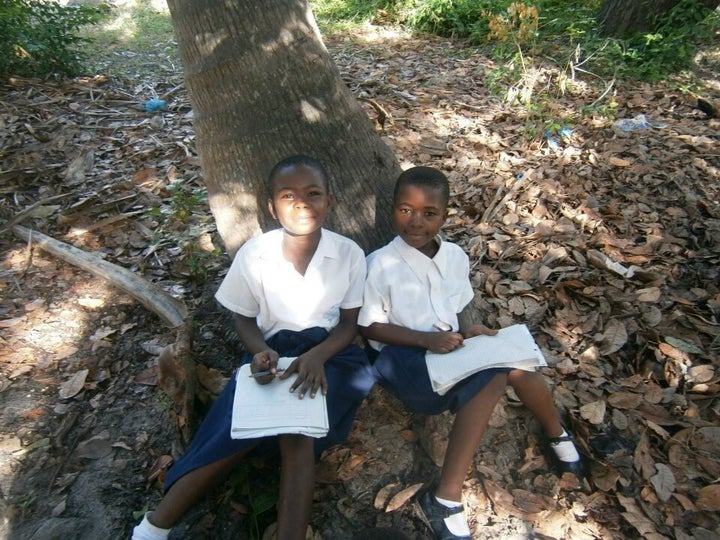From messing around in the classroom to bunking off with friends; education is a right taken for granted by many. Yet, it is also deprived to millions of children across the globe - 57 million at primary level to be precise. Worse still, a staggering 250 million children cannot read or count, even if they have attended school for up to four years. Good quality education is recognised as a vital tool for the economic and social growth of a country. Nevertheless, there remains a significant disparity, not only between the educational opportunities available to children between countries, but also between the academic experiences of boys and girls. So, in order to have a good education, it seems you need to win not only a geographical lottery, but a genetic one.

Young girls studying in Tanzania with Frontier volunteers
A study from 2008 estimated that 60 percent of the children who are not in education are female, and this problem only worsens with age. The divide becomes even more apparent at secondary level, where the majority of the 200 million children not in education are females. Whilst these figures may have improved somewhat, Sub-Saharan Africa, the Middle East and Southeast Asia are still areas of particular concern. Worryingly, four out of five women in Sub-Saharan Africa, for example, do not receive any form of formal education.
These figures are disturbing; but the problem becomes intensified when the greater costs of not educating females in the developing world are considered. The ripple effect of the gender divide stretches far beyond that of the individual. Research has shown that empowering females through education can lift entire families out of poverty, improve the health of populations, reduce unemployment, save the lives of children, reduce incidences of female genital mutilation, swell a county's agricultural output and Gross Domestic Product (GDP), and increase the number of women entering parliament. Furthermore, research suggests that in some countries HIV spreads twice as rapidly among uneducated girls, so the case can also be made that education also enforces healthier behaviours.
The social and individual benefits of education are dramatic and these rewards only increase generationally. Research suggests that educated women are more likely to ensure that their own daughters attend school, have the correct vaccinations and adopt healthier lifestyles overall. Seemingly, the facts speak for themselves: when women and girls are educated, the benefits reach across the whole of society. So, if educating more females has shown to enhance the progress of developing nations, surely it makes the urgency to improve these figures glaringly apparent?
Indeed, the U.N recognised this in their Millennium Development Goals (MDG's) set out in 2010, with the aims of achieving universal primary education by 2015. The U.S Department of State Journal, however, warns that 31 countries out of 196 are at risk of not even achieving gender parity in primary school enrolment rates by 2015. Of course, there are significant and varied barriers to be overcome in the challenge to educate the world's females. In too many countries education is not free, leaving many disadvantaged families unable to send some, or any, of their children to school. This can mean that parents favour their sons' education over their daughters, in the belief that they will be more able to support them in their old age. Even in areas of free education, some children need to work during the day to supplement their parent's income, or stay at home as a carer for their siblings. It is understandable why struggling families make these difficult decisions, but it means that girls often lose out on schooling solely because of the financial burden of education.
Aside from the economic reasons, the perhaps harder to solve barriers to education, are cultural opinions and ingrained social hierarchies. In Pakistan, these belief systems reportedly begin at school, where according to research; their textbooks elevate the status of the male and situate women as timid and submissive. It is these uniquely female issues that can stop girls from attending school. Megan Larson-Cone writes about Uganda, and how the basic issue of sanitary hygiene is preventing females from attending secondary education once a month, because they simply lack the materials to cope with their period. Other stories from parts of Africa speak of parents' hesitation to send their daughters to school because of the very real fear of sexual assault. For these problems, it seems there is more than just a financial and infrastructural solutions needed: a cultural shift in the ways that girls and women are socialised and depicted within these communities must occur.
The scope of the problem is large and daunting and the causes are as diverse as they are complex. Therefore, the methods used to reduce the gender divide in education generally takes a three pronged approach; tackling the social, financial and infrastructural fixtures in place. In order to improve the situation, there must be free education available, safe methods of transport to and from school, private toilet facilities for females, and more female members of staff- to name but a few. The curriculum must also be fully inclusive, and should strive to challenge any stereotypical views that reduce the roles of women in society.
We must also remember that gender parity is not the only goal. There needs to be good quality, accessible education for all. If you consider countries such as Liberia, where only 40 percent of eligible students were reported by UNICEF as enrolled in primary school, we still have a long way to go. So, whilst gender parity is an aim, it is not the ultimate goal. We should not be content until universal, good quality education is available to all, in spite of a child's geographical location, financial status or gender. But until then, creating equal opportunities for women and girls shines as a ray of hope amongst the many overbearing clouds that threaten universal education.
Want to help? English teachers are one of the most frequently requested resources from the communities, schools and organisations that Frontier works with. Having the ability to read and write English makes a valuable difference to the people within these communities as it gives people the chance to apply for higher paid jobs, substantially improving their standard of living. Find out more about projects teaching abroad.
Author Camilla James is an Online Journalism Intern at Frontier, an international non-profit volunteering NGO that runs over 300 conservation, community, and adventure projects in 57 countries across the globe. She can be found blogging on Frontier's Gap Year Blog or posting on the Frontier Official Facebook page.
